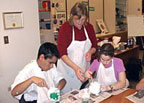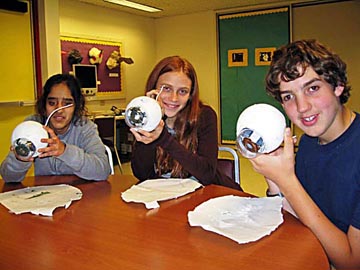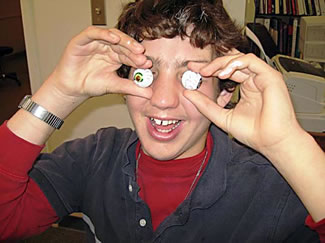Eye Ball Classes

Classes are in session for students and staff. Claire Becker's students and the morning dorm counselors are the first to participate in the "eye ball class" through CSB Low Vision Services. The curriculum includes basic understanding about how the eye is designed to work, which includes learning the names and placement of various parts of the eye.

Claire's class worked on learning eye parts by creating models of the eye from objects available from toy stores and hardware stores. Stove knob covers, which are made to keep toddlers from turning on the family stove, became the corneas. Five inch rubber balls are transformed into the shape of the eye, with cut outs for the irises and pupils. Toy magnifying glasses had the handles broken off to represent the lenses behind the pupils.

The students opted out of filling balloons with water for the aqueous and vitreous humors that hold the shape of the eyes, after hearing what a mess that made when the model idea was being developed. Telephone wire makes the optic nerves that connect the eye to the brain, plastic wrap lines the back of the "eyes" to represent the retina and a dot punched out of a sticky label is pasted near the optic nerve on the retina to represent the macula where detail vision and color information are collected by the eyes' cones.
Once the models were made the students have been giving reports on their own vision conditions, detailing what part of the eyes was affected by their particular conditions.
Meanwhile the dorm counselors are keeping up with the students by studying the eye as well. Every other week the counselors meet to discuss the various eye conditions which students have at the California School for the Blind. Three eye conditions stand out among children who are visually impaired or blind in industrialized countries, according to studies by the Blind Babies Foundation in northern California and by a nationalized medical system in a Scandinavian country. Not surprisingly, those three conditions have affected the majority of students here. They are cortical or neurological visual impairment (referred to as CVI), retinopathy of prematurity (ROP) and optic nerve hypoplasia which is part of the syndrome called septo-optic dysplasia. The dorm counselors are connecting the information they are learning about these conditions and others with the needs of the students they care for.
Events
- Summer Academies 2026
- California Braille Bee 2026
Wednesday, February 18, 2026
Thursday, February 19, 2026
- Spring Art Show
Wednesday, May 13, 2026
Thursday, May 14, 2026 - Learning Lab
- Short Courses 2025-2026
- General Tours
 (Google Form)
(Google Form)
Please fill out the Google Form if you are interested in attending any of our General Tour days.
Tuesday, January 27, 2026 at 11AM-12PM
Friday, February 20, 2026 at 11AM-12PM


